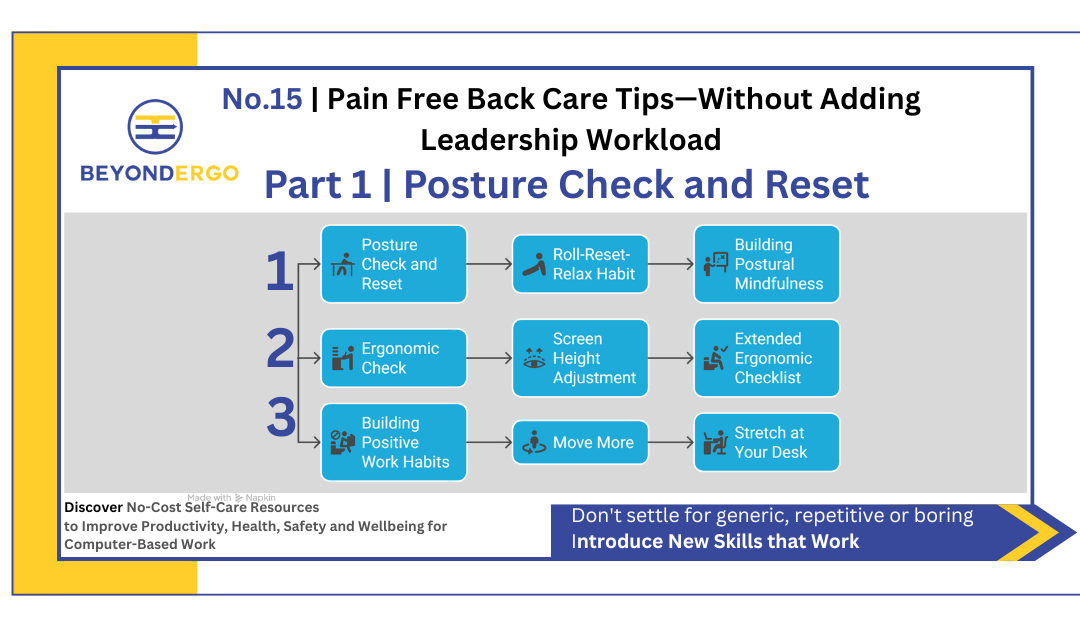Part 1: No-Cost Posture Checks + Daily Resets for Back Pain Relief
In today’s fast-paced work environment, many leaders are noticing increased stress and tension among their teams, particularly in the neck and upper back.
We understand the frustration when standard ergonomic solutions fall short. Sometimes, the perfect chair and keyboard setup aren’t enough to address your staff’s unique work environment challenges.
With increasing workloads and flexible work options, finding effective ways to support employee wellbeing without adding extra equipment, cost, or leadership tasks can be challenging.
That’s exactly where Beyond Ergo programs come in. We aim to simplify leadership by providing practical, research-backed strategies that address common causes of aches and pain and boost team well-being and productivity.
Over the next three months, we will share easy, no-cost actions based on our foundation skills program, the Three Pillars of Self-Care (Link – https://beyondergo.com.au/self-care-skills-training-screen-intensive-workers/ ). These small but powerful steps can:
-
- Reduce aches and discomfort
- Improve focus and energy
- Show your team you care
- Spark valuable conversations
- Enhance productivity
- Add a valuable leadership skill to your toolkit
These insights are quick to apply and simple to share, so feel free to forward these newsletters to other leaders who might find them helpful. Let’s make workplace wellness easier, together!
Our May Focus | Posture?
Poor posture is one of the biggest contributors to discomfort in computer-based work. The issue isn’t just about reminding staff to sit up straight; it’s about helping them develop postural mindfulness so they can recognise and correct tension points before they turn into pain points.
The problems? Poor Posture Often Feels Natural, and Laptops Mean Stoop Postures Are Increasingly Common.
Leaning forward or to the side while working has always been a common posture issue, leading to headaches, and back and shoulder pain. However, research reveals that the increasing use of laptops as primary work tools leads to more than additional physical strain.
This stooped posture, sometimes referred to as turtle posture, is commonly seen when using laptops, which means staff are holding this slouched posture for long periods. This awkward posture means:
-
- The head is jutting forward, putting the neck into compression, reducing blood flow and oxygen to the brain. This leads to fatigue, headaches, poor concentration, increased muscle tension and even injury to the vertebrae over time.
- The shoulders and back are rounded, increasing upper back and neck pain, and compressing the lungs. When this posture is held for an extended time, staff commonly experience an increasingly stiff neck with limited head rotation.
- The use of the laptop’s small keyboard, screen and input device also increases keying errors, increases the risk of repetitive strain injuries, and increases visual fatigue
In fact, WorkSafe Australia advises against using laptops as your main work device and recommends not using them flat on a desk for more than two hours a day. Download their Laptop Safety Guidelines
We also have to consider the effect on mental health. New research reveals that this slouched posture, with the person looking down (including the use of mobile phones), is associated with a decrease in subjective energy and increased feelings of helplessness, hopelessness, powerlessness and defeated thoughts.
Theory into Action | How to Coach
Action To Release Tension and Reset Posture | The Power of RRR: Reset, Release, and Relax
As we work at computers, we automatically build up a lot of tension in our neck and shoulders. This tension is a common cause of headaches, back and shoulder pain. The only way to release that tension is by doing big movements and consciously relaxing.
To relieve and prevent muscle tension, I encourage you to introduce the three RRRs (Roll, Reset and Relax) to your team. This simple action can reduce back and neck pain by up to 50%, just by making this action a regular habit that:
-
- Releases built-up muscle tension
- Resets posture back to a relaxed, neutral state
- Builds postural mindfulness to recognise and act on discomfort before it escalates
A great time to introduce the RRR at your next team meeting, especially if the meeting is at the end of a work week. This important self-care action is a great start to any meeting or easy circuit breaker at the end of a stressful day.
Before you share this action with your team, ask them how they feel. Who has stiff neck, back, or shoulder pain, or maybe a headache? Then, practice this simple sequence together and build the conversation about what tension points they released and the benefits they feel.
How to do the RRR Exercise:
1. Sit back in your chair with feet supported (or stand comfortably with soft knees)
2. Align your posture: Your ear should be over your shoulders, and your shoulders over your hips
3. Pull your spin to the sky with your chin slightly tucked in: Think ‘Tall head’. Let the world see your wonderful face
4. Now a little shoulder action: Pull shoulders firmly up, then back, then down, and now forward
5. Next, roll your shoulders back a couple of times, then forward a couple of times
6. Finally, take a deep breath and consciously relax
Ask your team: Who felt the crunch and crackle? That’s the built-up tension being released!
Building Positive Posture Habits through Supportive Team Coaching
Supporting your team doesn’t require long meetings or complex interventions. Here’s how you can help:
-
- Lead by example: Regularly do the RRR
- Share the knowledge: Teach your team how to check their posture
- Never single anyone out: Seeing people slouched in an awkward posture or hearing concerns about headaches or back pain creates a useful trigger for reminding everyone about the RRR. But never name anyone as the reason for the reminder.
- Make it a habit: Regularly talk about the value and benefits of self-care and encourage the Roll-Reset-Relax actions
- Pin up a reminder: Download and place the RRR poster in creative locations (e.g., stairwells, back of toilet doors)
- Share Positive Stories: Inviting or asking permission to share positive stories about the benefits of regularly doing the RRR is more than a reminder.
These stories are a powerful way to encourage others to adopt positive self-care habits into their daily routines.
Let’s Take Action
Supporting team wellbeing doesn’t have to be time-consuming. Simple actions like postural mindfulness and RRR can significantly reduce aches, boost energy, and prevent costly injuries.
Download the RRR guide and encourage your team to move more.
Movement is Medicine!
If you found this helpful, share this article with other leaders looking for simple, effective, no-cost ways to improve workplace wellness and productivity.
Limited time offer | Book before 30th of July 2025 to get 50% discount on our One-2-One Intensive | Available on site or virtually.
Is someone on your team struggling with workplace discomfort despite having an ergonomic equipment and workstation assessment?
Book a personalised one-to-one consultation that goes beyond standard ergonomic assessments.
Our specialist will:
-
- Identify overlooked pain triggers specific to your employee’s work patterns
- Create a tailored action plan addressing their unique physical needs
- Provide practical solutions that standard ergonomic reviews miss
Discover personalised programs | https://beyondergo.com.au/ergonomics-training-ph-0408751379/program-tasters/
Contact me to discover more | https://beyondergo.com.au/contact-us-ph-0408751379/
Take charge of your comfort at work—grab your Free Stretch at Your Desk sheet to loosen tight muscles and the Roll–Reset–Relax guide to release neck strain and restore posture. If pain is already affecting you, book a 1:1 consultation for personalised strategies that get you back on track.
Cheers
Liz
💡 Enjoyed this post?
Subscribe to our monthly newsletter for fresh insights and Beyond Ergo updates — straight to your inbox.

